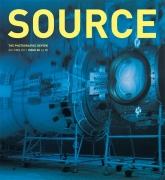Fabulous Identities
Rotimi Fani-Kayode — Autograph ABP (27th May - 30th July 2011)
Review by Catherine Grant
Issue 68 Autumn 2011
View Contents ▸
Approaching the exhibition space from the outside, three larger-than-life prints are overlaid with a quotation: "On three counts I am an outsider: in matters of sexuality; in terms of geographical and cultural dislocation and in the sense of not having become the sort of respectably married professional my parents might have hoped for." The voice of the Nigerian-born, London-based photographer Rotimi Fani-Kayode is explicitly foregrounded in this retrospective of his brief six-year career, with this particular statement having taken on a talismanic status, being almost always mentioned in writings on his photography.
This notion of Fani-Kayode’s outsider status is also how I first encountered his photography, in catalogues for exhibitions such as Ecstatic Antibodies: Resisting the AIDS Mythology, 1990, and from the debates around identity politics and queer theory that developed in the early 1990s. However, what struck me about this exhibition was that it was not simply a historical document, but how present and relevant the large-scale prints of his work felt in 2011. In part, this was due to the enlargement of two key series completed shortly before his death in 1989: Bodies of Experience and Ecstatic Antibodies. These colour scenes depict homoerotic, ambiguously cross-cultural rituals, incorporating Fani-Kayode’s Nigerian heritage from the Yoruba religion along with Christian and classical iconography. These idiosyncratic, baroque scenes range from portraits of lithe mythological characters to combinations of bodies, masks and objects that entertain a frenzy of symbolism, implying fantastic benedictions, rites of passage and erotic encounters. It is here, perhaps, in the almost impossible unpacking of the references in these scenes, that the need to frame Fani-Kayode’s practice with his own words comes into view. As his own HIV+ status became a central concern in his photography, there is a powerful energy in these works which one of the titles – Nothing to Lose – neatly summarises. Made in collaboration with his partner Alex Hirst, these works cannot be put into easy categories of disasporic, African, queer, autobiographical or erotic photography, although they embrace elements of all.  ‘Untitled’, 1987-1988
- Rotimi Fani-Kayode/ Autograph ABP
‘Untitled’, 1987-1988
- Rotimi Fani-Kayode/ Autograph ABP
The new prints have been made at a size of 48 inches square, the difference from the originals seen by the presentation of a number of vintage prints in the show, which are around a more modest 16 inches square. The curatorial strategy of enlarging these prints is not discussed, but their installation allows for a reconsideration of the intricacy of these scenes, and places Fani-Kayode’s practice within staged photography in recent art. Whilst Fani-Kayode and Hirst talk primarily about the spiritual references in this work, these new prints also brought out their cinematic quality, recalling Derek Jarman’s queer romanticism in contemporaneous films such as The Angelic Conversation from 1985, in which Shakespeare’s sonnets are presented as homoerotic love poems spoken between queer, punky angels. Similarly, FaniKayode’s early black and white portraits, which were also on show, brought to mind comparisons with Isaac Julien’s Looking for Langston, 1989, in which the interplay of black bodies is put into conversation with Robert Mapplethorpe’s infamous Black Book. Mapplethorpe’s black male nudes are often seen as a major influence for Fani-Kayode’s early work, but like Julien, the portraits on show here explore an ambivalence towards eroticising colour, something that is brought out in the continual play of black and white as a symbolic as well as photographic palette. The punk, confrontational quality of these works takes them out of identity politics by numbers (black+gay=political) and into a performative realm where race, religion and sexuality are still sites of fierce contestation.
Fani-Kayode’s urban, African, gay masculinity crossed over a number of politicised communities in the 1980s, which did not always create a space for his overtly homoerotic imagery, and is perhaps part of the reason he is not better known today. At a time in which the AIDS crisis was at its height, homosexuality was a still a difficult topic to address, particularly in the context of black communities. Combined with the backdrop of a Thatcherite London, with Section 28 passed in 1988 prohibiting the promotion of homosexuality by local authorities, FaniKayode’s status as outsider seems confirmed. However, this is only part of the context in which he worked. Fani-Kayode’s photography is intertwined with his activism in the black British art scene and responses to the AIDS crisis, with this exhibition venue being particularly apt, as he was one of the founding members of Autograph in 1988. Autograph hold Fani-Kayode’s archive, something which was indicated briefly in this show by the presence of polaroids and notebooks that tantalisingly pointed to previously unseen material held by the organisation. His engagement with Autograph, the Black Audio Film Collective and the Brixton Artist Collective, located his voice within communities which were resisting normative notions of identity and sexuality, as well as drawing on the legacies of punk that can be seen in the work of filmmakers such as Jarman.
Seeing Fani-Kayode’s romanticised, energising imaginings of fabulous identities today confirms that his work is important to recent histories of photography. Beyond this though, this exhibition was also an opportunity to think about the communities in which he worked, and how their creation of oppositional spaces and voices are useful in the current social climate. As notions of neglected archives and histories, both real and fantasised, concern many contemporary artists, the small sample of archival material on show points to further investigation into his work and its legacy, particularly the potential for seeing his work within a community, rather than as the lone voice of an outsider.
Other articles by Catherine Grant:
Other articles mentioning Robert Mapplethorpe:






